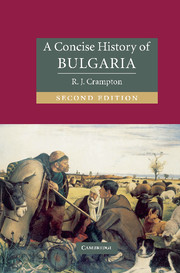Book contents
- Frontmatter
- Contents
- List of illustrations
- Preface
- Preface to the second edition
- Note on transliteration
- The Bulgarian lands: main rivers and mountains
- 1 THE BULGARIAN LANDS FROM PREHISTORY TO THE ARRIVAL OF THE BULGARIANS
- 2 MEDIAEVAL BULGARIA, 681–1393
- 3 OTTOMAN RULE IN THE BULGARIAN LANDS
- 4 THE NATIONAL REVIVAL AND THE LIBERATION
- 5 THE CONSOLIDATION OF THE BULGARIAN STATE, 1878–1896
- 6 FERDINAND'S PERSONAL RULE, 1896–1918
- 7 BULGARIA, 1918–1944
- 8 BULGARIA UNDER COMMUNIST RULE, 1944–1989
- 9 POST-COMMUNIST BULGARIA
- CONCLUSION
- Appendix 1 Bulgarian monarchs
- Appendix 2 Prime ministers of Bulgaria, 1879–2004
- Suggestions for further reading
- Index
- CAMBRIDGE CONCISE HISTORIES
7 - BULGARIA, 1918–1944
Published online by Cambridge University Press: 05 June 2012
- Frontmatter
- Contents
- List of illustrations
- Preface
- Preface to the second edition
- Note on transliteration
- The Bulgarian lands: main rivers and mountains
- 1 THE BULGARIAN LANDS FROM PREHISTORY TO THE ARRIVAL OF THE BULGARIANS
- 2 MEDIAEVAL BULGARIA, 681–1393
- 3 OTTOMAN RULE IN THE BULGARIAN LANDS
- 4 THE NATIONAL REVIVAL AND THE LIBERATION
- 5 THE CONSOLIDATION OF THE BULGARIAN STATE, 1878–1896
- 6 FERDINAND'S PERSONAL RULE, 1896–1918
- 7 BULGARIA, 1918–1944
- 8 BULGARIA UNDER COMMUNIST RULE, 1944–1989
- 9 POST-COMMUNIST BULGARIA
- CONCLUSION
- Appendix 1 Bulgarian monarchs
- Appendix 2 Prime ministers of Bulgaria, 1879–2004
- Suggestions for further reading
- Index
- CAMBRIDGE CONCISE HISTORIES
Summary
THE PEACE SETTLEMENT OF 1919
The peace treaty with Bulgaria was signed at Neuilly-sur-Seine on 27 November 1919. Bulgaria was required to relinquish all lands it had occupied during the recent conflict and it was also deprived of three small pockets on its western border, despite the fact that the vast majority of the local population was Bulgarian. Bulgaria also lost those parts of Thrace it had gained in the Balkan wars, although this loss was tempered somewhat by article 48 of the treaty which guaranteed Bulgaria ‘economic access’ to the Aegean; however, there was no indication of how that access was to be achieved. In peacetime it never was. The Neuilly settlement ruled that the Bulgarian army was to have a maximum effective strength of twenty thousand men, all of whom were to be volunteers. Reparations were to be paid both in kind and in money. Deliveries of coal, livestock and railway equipment were to be made to the governments of Greece, Yugoslavia and Romania, whilst Bulgaria was required to pay 2,250 million gold francs to the allies over a period of thirty-seven years. It was a preposterous sum and was soon recognised as such. In 1923 it was reduced to 550 million to be paid over sixty years, and in 1932 it was scrapped altogether.
Compared to Hungary, Germany and Austria the territorial provisions of the peace settlement were not harsh for Bulgaria.
- Type
- Chapter
- Information
- A Concise History of Bulgaria , pp. 144 - 179Publisher: Cambridge University PressPrint publication year: 2005

